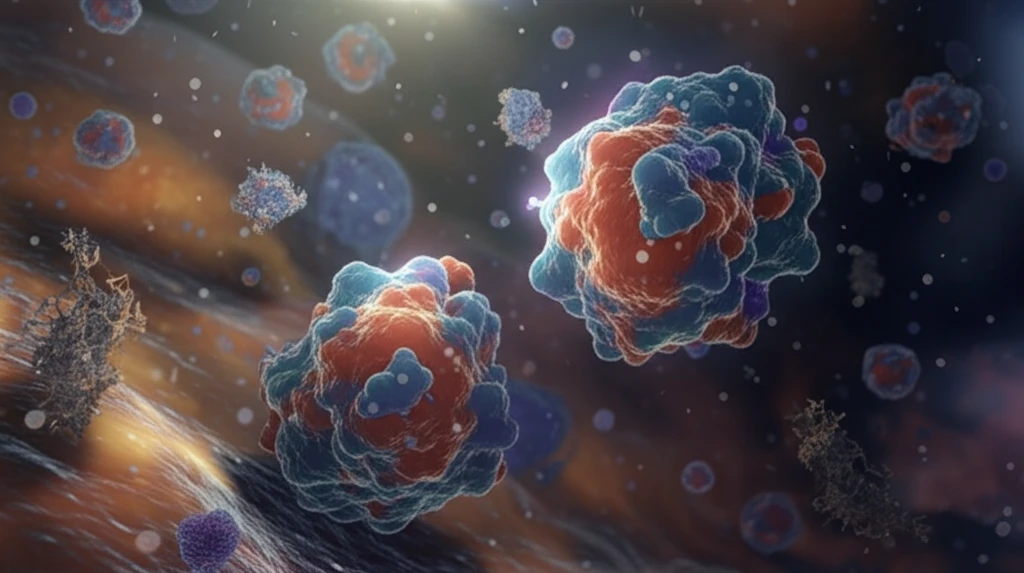
Unlocking Cellular Secrets: How Sugar and Protein Interactions Could Revolutionize Medicine
"Decoding the Specificity of N-acetyltransferases for New Therapeutic Strategies"
In the realm of molecular biology, N-terminal acetylation stands out as a pivotal post-translational modification. Affecting approximately 85% of eukaryotic proteins, this process influences various cellular functions, from DNA binding and protein-protein interactions to overall protein stability. Understanding N-terminal acetylation is not just an academic pursuit; it has profound implications for both normal cell biology and the understanding of pathological conditions.
Central to this process are N-terminal acetyltransferases (NATs), enzymes that catalyze the transfer of an acetyl moiety from acetyl coenzyme A (Acetyl-CoA) to a primary amine group on acceptor substrates. These substrates range from small molecules like aminoglycosides to large macromolecules, including diverse proteins. NATs are members of the GCN-5 related N-acetyltransferases family (GNAT), a vast group with over 100,000 members across all life kingdoms. Despite their abundance, sequence conservation within the GNAT superfamily is limited, reflecting their diverse substrate-binding and modifying capabilities.
Eukaryotic NATs, such as NatA-F, are essential in protein N-terminal acetylation, differing in subunit composition, substrate preferences, and resulting phenotypes. Although N-acetylated proteins are abundant in eukaryotes, only a few bacterial proteins have been found to undergo similar modifications. Recent research has focused on NATs like RimI, RimJ, and RimL from Salmonella enterica and YhY from Escherichia coli, believed to be homologs of eukaryotic NATs. A recent study sheds light on the unexpected capabilities of two NATs, GlmA and RmNag, derived from Clostridium acetobutylicum and Rhizomucor miehei, respectively. These enzymes, traditionally defined as glucosamine NATs, can also acetylate the free amino group on the first glycine residue of peptides. The research also includes human NAT Naa10p to widen the comparison and selectivity ranges.
What Makes These Enzymes Unique? Exploring Substrate Specificity

The study explores the substrate selectivity of three N-acetyltransferases – GlmA from Clostridium acetobutylicum, RmNag from Rhizomucor miehei, and Naa10p, a human recombinant N-acetyltransferase – against a range of hexosamines and synthetic peptides. GlmA and RmNag, previously identified as glucosamine N-acetyltransferases, surprisingly showed the capacity to acetylate the free amino group on the first glycine residue of peptides, albeit with varying catalytic efficiency. In contrast, Naa10p exhibited a preference for primary amine groups in peptides over glucosamine.
- Hexosamine Specificity: The enzymes were tested against glucosamine (GlcN), galactosamine (GalN), and mannosamine (ManN). All three NATs could acetylate GlcN, although Naa10p showed lower efficiency. RmNag could also partially acetylate GalN.
- Peptide Acetylation: GlmA and RmNag could acetylate peptides starting with glycine, indicating broader substrate specificity than initially thought.
- Residue Preferences: Further tests revealed that both enzymes disliked negatively charged residues at the +2 or +3 positions following the N-terminal glycine. RmNag showed more flexibility and efficiency in peptide acetylation compared to GlmA.
- Comparison with GlcN-Linked Peptides: GlmA preferred GlcN over peptides, while RmNag showed almost equal activity towards both, suggesting diverse roles in cellular metabolism. Naa10p preferred peptides with acidic N-termini over GlcN.
Future Implications and Applications
In conclusion, this research provides a comprehensive comparison of three distinct NATs, revealing their unique substrate preferences. GlmA is best suited for modifying glucosamine, while Naa10p excels in peptide N-terminal acetylation. RmNag, with its flexible substrate selectivity, may play diverse roles in cellular metabolism. By understanding these enzymes' specificities, researchers can better apply them in biotechnological applications and develop targeted therapies.
